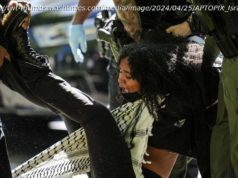The White House says Trump meant to send a message to Kim Jong Un in a language he can understand. But it’s risky.
WASHINGTON — President Trump’s use of apocalyptic imagery in threatening “fire and fury” against North Korea represented some of the most bellicose language uttered by any president since World War II.
Speaking at his New Jersey golf club on Tuesday, Trump warned: “North Korea best not make any more threats to the United States. They will be met with fire and fury like the world has never seen.”
Trump’s statement, in response to reports that the communist regime had developed a warhead that could be mounted on a ballistic missile, mirrored a North Korean propaganda machine that once threatened to turn the South Korean capital into a “sea of fire.”
U. S. officials say that’s exactly the plan. Secretary of State Rex Tillerson said Wednesday that the president’s words were designed to send a clear message to North Korea’s enigmatic leader “in language that Kim Jong Un can understand.”
But the message seemed to only escalate the tension. North Korean Gen. Kim Raj Gyom on Thursday repeated a threat to target the U. S. territory of Guam with what he called “historic enveloping fire” from four ballistic missiles.
He called Trump’s threat “a load of nonsense” and said “sound dialogue is not possible with a such a guy bereft of reason and only absolute force can work on him.”
The escalating war of words raises the risk of a high-stakes miscalculation. “What we have is two schoolyard bullies out-threatening each other, ” said Stephen Miles, director of Win Without War, a coalition of liberal advocacy groups.
“The problem with that is that it has the tendency to turn into a self-fulfilling prophesy. You end up with conflict coming out of a misunderstanding, and one side feeling they have to attack first, ” he said.
Related:
Saber-rattling is as old as diplomacy itself — and can be effective in bringing about a negotiation.
“I think the president just wanted to be clear to the North Korean regime on the U. S. unquestionable ability to defend itself, will defend itself and its allies, and I think it was important that he deliver that message to avoid any miscalculation on their part, ” Secretary of State Rex Tillerson said Wednesday. And Defense Secretary Jim Mattis appeared to embrace this approach, telling Pyongyang to “cease any consideration of actions that would lead to the end of its regime and the destruction of its people.”
But veteran Korea watchers say that Trump’s statements are likely to be counterproductive. “Yes, this is language that Kim Jong Un and his generals might understand very clearly, ” said Tim Shorrock, a journalist with the Korea Center for Investigative Reporting. “But this language isn’t just heard by Kim Jong Un, but it’s heard by millions of people who live in the region.”
It’s a region where cultural memories of World War II, atomic bombs and the Korean War war are still raw.
And Trump’s original threat was followed up with a Wednesday tweet boasting that the U. S. nuclear arsenal is “far stronger and more powerful than ever before.”
Trump’s bombast isn’t entirely unprecedented. Historians were quick to point out the similarities to President Harry Truman’s threat to Japan after the dropping an atomic bomb on Hiroshima: “If they do not now accept our terms they may expect a rain of ruin from the air, the like of which has never been seen on this earth, ” Truman said.
And such statements can even be effective, as in the Cuban Missile Crisis. “We will not prematurely or unnecessarily risk the costs of worldwide nuclear war in which even the fruits of victory would be ashes in our mouth — but neither will we shrink from that risk at any time it must be faced, ” President John F. Kennedy said then, promising “a full retaliatory response upon the Soviet Union” in the event of a missile launch from Cuba.
But experts said Trump’s threats might backfire, in part because he doesn’t have any plausible military options for backing it up. With vast artillery pointed at Seoul, South Korea, even a conventional war on the peninsula could claim millions of lives.
“Interpreting the statement literally makes it almost ridiculous, ” said Roseanne McManus of the City University of New York, author of Statements of Resolve: Achieving Coercive Credibility in International Conflict.
That’s because Trump’s threat was so vague, leaving open to possibility of a nuclear attack in response to non-specific North Korean “threats.” She’s found that presidential saber-rattling can is most effective when it’s credible, specific – and understood.
Trump has already earned an international reputation for blustering, and his comments aren’t backed up by public opinion or bipartisan support in Congress, McManus said.
Indeed, House Minority Whip Steny Hoyer, D-Md., said the threat was “reckless.”
“No matter how much the Kim regime deserves international condemnation and action — which it does — it is not a strategic or responsible response to issue wild threats of destruction. Such is behavior we’d expect to see from Mr. Kim himself, not the president of the United States, ” he said Wednesday.
It’s also unclear how much Trump’s statement reflects the thinking of his own administration. The White House pushed back Wednesday on suggestions that the remarks took national security officials off guard.
“The words were his own, ” White House press secretary Sarah Huckabee Sanders said. “The tone and strength of the message were discussed beforehand.”
Trump’s comments came in response to a question about North Korea’s nuclear capabilities as Trump sat down for a briefing on the opioid crisis.
Tillerson, who spoke to reporters on his way to Guam for a pre-scheduled stop, said Americans should “have no concerns about this particular rhetoric of the last few days.
Home
United States
USA — Science Analysis: Trump mirrored North Korea's own rhetoric with threat of 'fire and...






